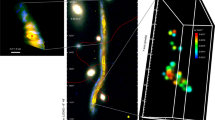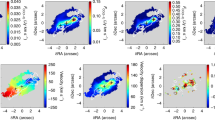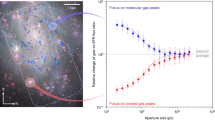Abstract
Stars and planets form within dark molecular clouds, but little is understood about the internal structure of these clouds, and consequently about the initial conditions that give rise to star and planet formation. The clouds are primarily composed of molecular hydrogen, which is virtually inaccessible to direct observation. But the clouds also contain dust, which is well mixed with the gas and which has well understood effects on the transmission of light. Here we use sensitive near-infrared measurements of the light from background stars as it is absorbed and scattered by trace amounts of dust to probe the internal structure of the dark cloud Barnard 68 with unprecedented detail. We find the cloud's density structure to be very well described by the equations for a pressure-confined, self-gravitating isothermal sphere that is critically stable according to the Bonnor–Ebert criteria1,2. As a result we can precisely specify the physical conditions inside a dark cloud on the verge of collapse to form a star.
This is a preview of subscription content, access via your institution
Access options
Subscribe to this journal
Receive 51 print issues and online access
$199.00 per year
only $3.90 per issue
Buy this article
- Purchase on Springer Link
- Instant access to full article PDF
Prices may be subject to local taxes which are calculated during checkout


Similar content being viewed by others
References
Ebert, R. Uber die Verdichtung von HI-Gebieten. Z. Astrophys. 37, 217–232 (1955).
Bonnor, W. Boyle's Law and gravitational instability. Mon. Not. R. Astron. Soc. 116, 351–359 ( 1956).
Alves, J., Lada, C. & Lada, E. Correlation between gas and dust in molecular clouds: L977. Astrophys. J. 515, 265–274 ( 1999).
Chandler, C. & Richer, J. The structure of protostellar envelopes derived from submillimeter continuum images. Astrophys. J. 350, 851–866 (2000).
Lada, C., Lada, E., Bally, J. & Clemens, D. Dust extinction and molecular gas in the dark cloud IC 5146. Astrophys. J. 429, 694–709 ( 1994).
Alves, J., Lada, C. J., Lada, E. A., Kenyon, S. J. & Phelps, R. Dust extinction and molecular cloud structure: L 977. Astrophys. J. 506, 292– 305 (1998).
Lada, C., Alves, J. & Lada, E. Infrared extinction and the structure of the IC 5146 dark cloud. Astrophys. J. 512, 250–259 (1999).
Bok, B. & Reilly, E. Small dark nebulae. Astrophys. J. 105, 255–257 ( 1947).
Clemens, D. & Barvainis, R. A catalog of small, optically selected molecular clouds: optical, infrared, and millimeter properties. Astrophys. J. Suppl. Ser. 68, 257– 286 (1988).
de Geus, E., de Zeeuw, P. & Lub, J. Physical parameters of stars in the Scorpius-Centaurus OB association. Astron. Astrophys. 216, 44–61 (1989).
Bourke, T., Hyland, A., Robinson, G., James, S. & Wright, C. Studies of star formation in isolated small dark clouds—II A southern ammonia survey. Mon. Not. R. Astron. Soc. 276, 1067–1084 (1995).
Quigley, M. & Haslam, C. Structure of the radio continuum background at high galactic latitudes. Nature 208, 741–743 (1965).
Breitschwerdt, D., Freyberg, M. & Egger, R. Origin of H I clouds in the local bubble. Astron. Astrophys. 361, 303–320 (2000).
Reipurth, B., Nyman, L. & Chini, R. Protostellar candidates in southern molecular clouds. Astron. Astrophys. 314, 258– 264 (1996).
Moorwood, A., Cuby, J. & Lidman, C. SOFI sees first light at the NTT. ESO Messenger 91, 9–13 (1998 ).
Appenzeller, I. et al. Successful commissioning of FORSI—the first optical instrument on the VLT. ESO Messenger 94, 1–6 (1998).
Mathis, J. Interstellar dust and extinction. Annu. Rev. Astron. Astrophys. 28, 37–70 ( 1990).
Bok, B. Centennial Symposia (Harvard Observatory Monographs No. 7, Harvard-College Observatory, Cambridge, 1948).
Lane, J. Am. J. Sci. Arts, Series 2 4, 57 ( 1870).
Emden, R. Gaskugeln (Teubner, Leipzig, 1907).
Chandrasekhar, S. in An Introduction to the Study of Stellar Structure 156 (Dover, Toronto, 1967).
Mckee, C. in The Origin of Stars and Planetary Systems (eds Lada, C. & Kylafis, N.) 29–66 (Kluwer, Dordrecht, 1999).
Nakano, T. Quasistatic contraction of magnetic protostars due to magnetic flux leakage—Part One—formulation and an example. Publ. Astron. Soc. Jpn 31, 697–712 (1979).
Lizano, S. & Shu, F. Molecular cloud cores and bimodal star formation. Astrophys. J. 342, 834– 854 (1989).
Basu, S. & Mouschovias, T. Magnetic braking, ambipolar diffusion, and the formation of cloud cores and protostars I—Axisymmetric solutions. Astrophys. J. 432, 720– 741 (1994).
Shu, F., Allen, A., Shang, H., Ostriker, E. & Li, Z. in The Origin of Stars and Planetary Systems (eds Lada, C. & Kylafis, N.) 193–226 (Kluwer, Dordrecht, 1999).
Mouschovias, T. & Ciolek, G. in The Origin of Stars and Planetary Systems (eds Lada, C. & Kylafis, N.) 305 –340 (Kluwer, Dordrecht, 1999).
Rucinski, S. & Krautter, J. TW Hya: a T Tauri star far from any dark cloud. Astron. Astrophys. 121, 217–225 (1983).
Reipurth, B. Star formation in Bok globules and low-mass clouds. I—The cometary globules in the Gum Nebula. Astron. Astrophys. 117, 183–198 (1983).
Launhardt, R. & Henning, T. Millimetre dust emission from northern Bok globules. Astron. Astrophys. 326, 329 –346 (1997).
Acknowledgements
We thank M. Lombardi for fruitful discussions and assistance, the Paranal Science Operations team for observing Barnard 68 with FORS1 on Very Large Telescope (VLT) Antu, R. West and E. Janssen for composing Figure 1 top, and R. Hook and R. Fosbury for composing Figure 1 bottom. We also thank M. Petr for helpful discussions during the preparation of the VLT observations. E.A.L. acknowledges support from a Presidential Early Career Award for Scientists and Engineers to the University of Florida.
Author information
Authors and Affiliations
Corresponding author
Rights and permissions
About this article
Cite this article
Alves, J., Lada, C. & Lada, E. Internal structure of a cold dark molecular cloud inferred from the extinction of background starlight. Nature 409, 159–161 (2001). https://doi.org/10.1038/35051509
Received:
Accepted:
Issue Date:
DOI: https://doi.org/10.1038/35051509
This article is cited by
-
Astromodal wave dynamics in multifluidic structure-forming cloud complexes
Pramana (2021)
-
Cold clouds as cosmic-ray detectors
Communications Physics (2020)
-
The Origin of the Stellar Mass Distribution and Multiplicity
Space Science Reviews (2020)
Comments
By submitting a comment you agree to abide by our Terms and Community Guidelines. If you find something abusive or that does not comply with our terms or guidelines please flag it as inappropriate.



